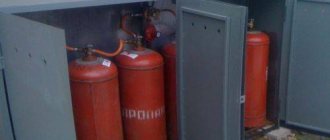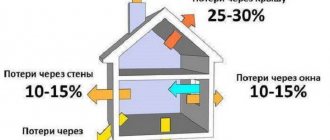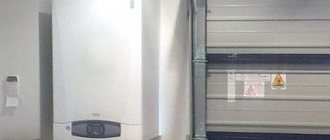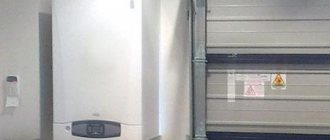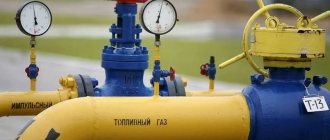It is well known that gas tanks are increasingly used for heating houses and cottages with permanent or long-term residence. It is also undisputed that a large share of the budget for heating a house is the cost of fuel. In our case it is liquefied gas.
Therefore, a prudent home owner must know how to correctly calculate the gas consumption from a gas tank for heating and be able to predict the intervals between refills. This is also relevant because gas delivery, as a transport service, has its own quite significant price.
We will help you in an accessible manner to independently calculate the consumption of liquefied gas for heating your home in gas supply systems with a gas holder. This knowledge is relevant when designing the construction of a new house and planning the reconstruction of an existing heat supply system. Correctly carried out calculations will allow you to control gas consumption and reduce gas costs.
Factors affecting gas consumption
The gas holder has the form of a volumetric tank that is filled with liquefied petroleum gas (LPG). This is a mixture of two gases - propane and butane.
Autonomous heating schemes with gas extraction from a gas tank and a gas boiler in the system have become a modern alternative to heating houses from solid fuel or diesel boilers
Storing gas in such tanks, with its further use for heating the house, may be due to the following factors:
- the inability to tie into the main gas pipe or the high cost of such a connection;
- constant and unresolved by gas services problems with gas pressure in the central pipeline.
For normal operation of most gas boilers, the gas pressure in the pipeline must be at least 35 mbar. This standard is often not maintained in main gas pipelines and ranges only from 8 to 22 mbar.
To determine the volume of liquefied gas in a tank, there are mechanical level gauges or more modern remote telemetry systems. Such equipment can be supplied complete with the tank or purchased separately. The average daily gas consumption can also be determined by the difference in gas meter readings, if available.
But a more accurate answer to the question of how much gas in a gas holder is enough to heat a home, what its consumption is and how to minimize costs for it, mathematical calculations will help. And this despite the fact that objectively such a calculation will be of an average nature.
Fuel in an independent gas supply from a gas holder is consumed not only for heating. Although in much smaller volumes, it is also spent on heating water, operating a gas stove and other household needs.
It should be taken into account that gas consumption is influenced by the following factors:
- climate of the region and wind rose;
- square footage of the house, number and degree of thermal insulation of windows and doors;
- material of walls, roof, foundation and the degree of their insulation;
- number of residents and mode of their stay (permanently or periodically);
- technical characteristics of the boiler, the use of additional gas appliances and auxiliary equipment;
- number of heating radiators, presence of heated floors.
These and other conditions make the calculation of fuel consumption from a gas tank a relative value, which is based on average accepted indicators.
Costs with an electric boiler
Now let's look at the capabilities of the electric boiler. In this case, you need to understand whether the allocated power limit is enough for you? Secondly, two-tariff electricity metering is already implemented almost everywhere.
Let's look at two options: single-tariff and two-tariff.
Single tariff option
Accordingly, the cost of 1 kW/h of heat from an electric boiler is 4.04 rubles. In this case, savings can be achieved by using automation so as not to overheat the room needlessly.
Two-tariff option
In the two-tariff version, together with an electric boiler, a storage tank of the appropriate volume is installed. In this case, the boiler mainly operates at night, at maximum power, at the night tariff.
It heats the room, and excess heat goes into the storage tank. Then, during the day, the room is heated using the heat accumulated at night at the night tariff.
Sometimes this heat is not enough and the boiler does not heat the house, sometimes this heat is produced in excess, so we take into account that heating occurs only at the night rate. The cost of 1 kW/h of electricity in the Moscow region for 2022 (at night tariff) is 1.26 rubles
The cost of 1 kW/h of electricity in the Moscow region for 2022 (at night tariff) is 1.26 rubles.
The efficiency of an electric boiler is 1. In this case, the cost of 1 kW/h of heat from an electric boiler is 1.26 rubles.
That is, the cost will be a similar figure to the cost of electricity at the night tariff and will be equal to 1.26 rubles.
Gas boiler power calculation
The main share of fuel consumption is heating. An important parameter of any house or apartment that affects the amount of gas spent on heating is the heat loss indicator. The task of heating is precisely to correctly compensate for these losses, creating conditions for comfortable living.
In order to calculate the need for liquefied gas, it is necessary to determine the amount of heat loss at home or the thermal power required for full heating. The rated power of the heating system - gas boiler - depends on this indicator
As a standard for calculations, we will take a house located in an area with an average climate, in satisfactory condition and insulated in accordance with technology. The area of the house is 80 m2.
The average values of heat loss and boiler power can be determined by the quadrature of the area.
The formula looks like:
Q = S × Рр /10 , where
Q—calculated heat losses (kW);
S is the area of the premises that are heated (m2);
Рр - specific power of a gas boiler (kW/m2) - power for every 10 m2.
The specific power for heating an area of 10 m2 has already been approximately established, taking into account adjustments for regions with different climates. For our reference house, located, for example, in the Moscow region, Рр = 1.2 - 1.5 kW.
Taking into account a house area of 80 m2, the optimal power of the heating system will have the following value:
Q = 80 × 1.2 / 10 = 9.6 kW.
Although simplified, this formula reflects the most accurate results.
Often, for convenience in carrying out calculations, unit is taken as the value of specific power. Based on this, the power of the heating system is taken at the rate of 10 kW per 100 m2 of heating area.
Since the gas supply system of your home includes not only heating, but also water heating and other equipment, the boiler power is determined by adding 20-25% of the reserve to the calculated heat losses
The second option, but accepted with a greater degree of error, is to calculate the cost of thermal energy for the heat loss of a building by cubic capacity - the volume of heated premises. Depending on the climate zone, 30 - 40 W are allocated for heating one cubic meter of a room with a ceiling height of up to 3 m.
Calculation of gas flow from a gas tank
Calculating the heating consumption of the mixture from the gas storage used in the heating system of the house has its own characteristics and differs from calculating the consumption of main natural gas.
The predicted volume of gas consumption is calculated using the formula:
V = Q / (q × η) , where
V is the calculated volume of LPG, measured in m³/h;
Q—calculated heat losses;
q is the smallest specific value of the heat of combustion of the gas or its calorie content. For propane-butane this value is 46 MJ/kg or 12.8 kW/kg;
η – efficiency of the gas supply system, expressed in absolute value per unit (efficiency/100). Depending on the characteristics of the gas boiler, the efficiency can range from 86% - for the simplest ones, to 96% - for high-tech condensing units. Accordingly, the value of η can range from 0.86 to 0.96.
Let's assume that the heating system is planned to be equipped with a modern condensing boiler with an efficiency of 96%.
Substituting the values we accepted for calculation into the original formula, we obtain the following average volume of gas consumed for heating:
V = 9.6 / (12.8 × 0.96) = 9.6 /12.288 = 0.78 kg/h.
Since the LPG filling unit is usually considered to be a liter, it is necessary to express the volume of propane-butane in this unit of measurement. To calculate the number of liters in the mass of a liquefied hydrocarbon mixture, it is necessary to divide kilograms by density.
The table shows the test density of liquefied gas (in t/m3), at various average daily air temperatures and in accordance with the ratio of propane to butane expressed as a percentage
The physics of the transition of LPG from liquid to vapor (working) state is as follows: propane boils at minus 40 °C and above, butane - from 3 °C with a minus sign. Accordingly, the 50/50 mixture will begin to transition into the gaseous phase at a temperature of minus 20 °C.
For middle latitudes and a gas tank buried in the ground, such proportions are sufficient. But, in order to protect yourself from unnecessary hassle, it is optimal in winter conditions to use a mixture with at least 70% propane content - “winter gas”.
Taking the calculated density of LPG as 0.572 t/m3 - a 70/30 propane/butane mixture at a temperature of -20 °C), it is easy to calculate the gas consumption in liters: 0.78 / 0.572 = 1.36 l/h.
Daily consumption with such gas selection in the house will be: 1.36 × 24 ≈ 32.6 l, during the month - 32.6 × 30 = 978 l. Since the obtained value was calculated for the coldest period, adjusted for weather conditions, it can be divided in half: 978/2 = 489 liters, on average per month.
The duration of the heating season is calculated from the moment when the average daily outside temperature does not exceed +8 degrees Celsius for 5 days. This period ends in the spring, with stable warming
In the area we took as an example (Moscow region), this period averages 214 days.
Gas consumption for heating during the year when calculated will be: 32.6/2 × 214 ≈ 3488 liters.
How to convert a heating boiler to liquefied gas
The main difference between natural gas and liquefied gas is that the former is supplied and burned at a higher pressure. The automation of conventional equipment is configured for indicators equal to 6-12 atm. When the readings drop, the pressure sensor is triggered, turning off the burner.
Operating a heating boiler using a propane-butane mixture requires changing the configuration and parameters:
- It is necessary to change the supply speed of the gas-air mixture.
- You will need to install a set of liquefied gas jets.
- Configure automation for other operating parameters.
Modern single-circuit and double-circuit heating boilers are designed to operate on liquefied and main gas. Conversion requires replacing the nozzles and switching the boiler to another mode.
The technical conditions for the use of liquefied gas in individual boilers not intended for this type of fuel differ significantly. In addition to replacing the jets, complex reconfiguration of the automation and control valves will be required.
It is difficult to correctly regulate the gas supply to the boiler when switching to liquefied gas, set the minimum pressure limit and perform other work independently, without special skills. According to current regulations, all work must be performed exclusively by licensed specialists.
The technical documentation of heating equipment indicates the minimum pressure at which the burner continues to operate. The lower this indicator, the more propane-butane mixture it will be possible to use from a filled fuel tank. Typically, 15-30% of the total volume remains in the container.
Nozzles for boilers for liquefied gas
In the section on how to convert a heating boiler to the flow rate of a gas boiler running on liquefied gas, the need to replace nozzles or nozzles was mentioned. Re-equipment is required for several reasons:
- The difference between nozzles for liquefied and main gas is the different diameters of the outlet. As a rule, jets for a propane-butane mixture are narrower.
- After installing a set of nozzles to convert the heating boiler from natural gas to liquefied gas, the pressure in the system increases slightly.
- The reduced diameter of the nozzle leads to a decrease in the flow rate of the gas-air propane-butane mixture. For normal operation of a 10 kW unit, the pressure is required to be no more than 0.86 kg/hour.
Injectors or jets are sold in sets. Some manufacturers include in the basic package all the fittings necessary for conversion. In other cases, the kit will have to be purchased separately.
What is the liquefied gas consumption of the boiler?
The volume of liquefied gas consumption in gas heating boilers is indicated in the technical documentation provided by the manufacturer. It is different for all models and depends on several factors:
- Performance.
- Burner type.
- Equipment setup.
The technical characteristics of liquefied gas consumption are also affected by how suitable the selected model is for a given type of fuel. On average, for a 10-15 kW unit, you will need 2 cylinders per week and per month.
Which gas is more profitable to heat - natural or liquefied?
Comparative consumption of natural and liquefied gas when operating a heating boiler shows that it is more profitable to heat a house when boiler equipment is connected to the main line. Heating with a propane-butane mixture should only be used in the following cases:
- Changes in the design and reconfiguration of the boiler when using liquefied gas are temporary. From the start of registration and ordering of a project for the installation of heating equipment connected to the main gas pipeline, it may take about six months. During this period, it is not economically feasible to heat the premises with electric or solid fuel heating equipment specially purchased for this purpose. The cost of converting a conventional boiler to liquefied gas ranges from 500-1000 rubles.
- Connecting a gas holder - in this case, the cost of using the mixture is more profitable than heating with wood, electricity or diesel fuel. The only condition is that a qualified specialist must adjust the pressure of liquefied gas and regulate the operation of the automation. Incorrect settings lead to an increase in consumption by approximately 15%.
The economic component, operational safety, the possibility of switching back to natural gas - all these factors make it advisable to use boilers running on liquefied gas.
Selecting the optimal gas tank for consumption
A gas tank is expensive equipment that is purchased and installed for more than one year. Not only the efficiency of the home heating system largely depends on its correct choice. Heating costs may indirectly depend on the type and type of liquefied gas storage facility.
Comparison of above-ground and underground gas tanks
An above-ground gas holder is a cheaper option for autonomous gasification. Such tanks are usually smaller in volume and their installation does not require expensive excavation work.
But, when using above-ground gas tanks for heating needs in winter, it is necessary to take into account that the evaporation of the propane-butane mixture during this period will be reduced and problems with gas pressure are possible.
For more efficient and productive operation of a ground-based gas tank, at a minimum, it will be necessary to equip it with an evaporation unit and insulate the walls of the tank
It is possible, of course, to reduce the temperature threshold for the transition of LPG into the gaseous phase of fuel due to a higher content of propane in the mixture. But this will entail additional costs, since such gas is more expensive than butane.
Underground gas tanks are the most popular storage facilities for LPG.
Such a buried tank in an average climate does not require additional equipment for heating and thermal insulation
The depth of immersion of the container should be such that the layer of soil above it is at least 0.6 m. This will protect the storage from freezing and mechanical damage.
Vertical or horizontal gas holder
There are two types of recessed gas tanks in shape:
- Vertical.
- Horizontal.
These containers differ from each other not only in design, but also functionally - in the surface area of the liquefied mixture, called the “evaporation mirror”.
Horizontal gas holders have a larger “mirror”. Due to this, steam formation occurs more intensively, with a pressure sufficient for the correct operation of the heating system
Vertical storage facilities are more often used in autonomous gas systems of small houses or cottages, if their full heating is not required in winter.
For efficient and stable operation of vertical gas tanks in winter, it is necessary to insulate the tank or use special heaters, which increases the overall cost of gas supply to the house
Features of a mobile gas tank trailer
A mobile gas holder allows you to solve the problem of heating and creating comfortable living conditions in winter at summer cottages with temporary residence, objects under construction, where gas storage equipment is impractical or technically impossible.
This is a trailer-mounted tank with a capacity of 500-600 liters. How long such a gas tank with a capacity of 600 liters will last can be predicted by taking the average standard used - 30-40 liters of liquefied gas per 1 square meter of room.
An approximate calculation shows that an insulated house of 100 m2 can be independently heated with a mobile gas tank for a month, maintaining a comfortable temperature for living.
It should be understood that the operation of a mobile gas tank as a ground-based tank in winter or in northern regions will require insulation and forced heating of the tank. For this reason, a trailed gas tank is not a completely acceptable heating option.
How to choose a gas tank by volume
Of the typical underground gas tanks, tanks with volumes of 2700 liters and 4850 liters are optimally suitable for country houses and cottages.
When choosing the standard size of a gas storage facility, the following factors must be taken into account:
- If you live permanently in a house with autonomous heating, it is advisable to refill the tank twice a year. This is due to different concentrations of butane and propane in mixtures intended for use in summer and winter.
- The tank should be filled with liquefied phase by 85%. The remaining free volume in the storage is a vapor cushion for hydrocarbons in the evaporation phase.
Therefore, when calculating how much gas can be enough in a gas holder with a capacity of 2700 liters or in a gas storage facility of other sizes, it is necessary to take into account that the rated total volume of a gas holder and its filling volume are not the same thing.
The table shows the filling capacities of typical gas tanks of Eurostandard-2, in relation to the optimal area of heated areas and boiler power
Our calculation of the average values of liquefied gas withdrawal from a gas tank and generally accepted standards allow us to determine the frequency of refilling gas tanks. With an average annual gas consumption of 30 liters per 1 m2 of heated area, refilling a 2295 liter liquefied gas tank in a 2700 liter tank for a 100 m2 house will be sufficient for 9 months.
Using the same method, but for a house of 150 m2, we calculate how much LPG will be enough in a heating system from a 4850 liter gas tank. During the year, 4500 liters are consumed, so a filling volume of 4122 liters is enough to heat the house for 10 months.
From the calculations it is clear that refueling will have to be done twice a year. And this is economically justified due to the use of “summer” and “winter” LPG.
Is it worth fooling yourself with calculations?
Indeed, it would seem why it is needed - after all, the boiler’s passport data usually indicates the approximate gas consumption. Multiply it by the number of hours of work - and here is the finished result!
Well, try it, multiply... You will almost certainly end up with such a high consumption rate that it will become scary! And why? Yes, because the nameplate power of the boiler and the real value of the necessary thermal energy to ensure full heating are far from the same thing!
And what is the value of multiplying? The passport may show a range, that is, two boundaries - minimum and maximum flow. And the difference between them is very significant.
Table with passport data of the Navien Prime line of gas boilers. There are no specifics either on the area of heated premises or on gas consumption (and there cannot be). So what should we take into account?
The fact is that the nameplate power of the boiler is its maximum capabilities. And it is quite natural that when choosing equipment, a certain reserve is always laid down. For example, by carrying out calculations it was found that 8.6 kW of thermal energy is needed to heat a house. The optimal solution would be to purchase a boiler with an upper power limit of 10÷12 kW. There is quite a solid reserve of power, but at the same time, this reserve does not look excessive, leading to an unjustified increase in the cost of equipment.
It is far from certain that this reserve will ever be in demand. But anything can happen - for example, an abnormally cold winter for a particular region.
That is, when choosing a boiler, it is important to find a model that would become the “golden mean”, fully meeting the needs for thermal energy for the most unfavorable conditions and with an adequate power reserve.
But what will the gas consumption be during normal operation of the boiler, and not at the limit of its capabilities?
It would be more correct to base the calculations on the actually required thermal power of the heating system and on the energy potential of the fuel used. This is exactly the algorithm proposed in this publication.
Well, knowing the predicted flow rate has quite practical applications. For example, an expense item of the family budget is set for the upcoming heating season. And when using not network, but imported liquefied gas, this also means planning the regularity and volumes of replenishment of “blue fuel” reserves.
Information about normal gas consumption often helps to identify emerging problems and outline ways to maximize resource savings.
In addition, information about consumption rates can act in a unique psychological way. For example, it can stimulate home owners to analyze consumption and seek opportunities for maximum resource savings.
You may be interested in information about what types of electric boilers are available for heating a private home
Tips for saving gas
You can reduce gas consumption from a gas tank by performing the following energy-saving measures:
- insulation of walls, roofs, attics, basement floors;
- replacing old window units with modern double-glazed windows with frost-free profiles;
- optimal setting of boiler parameters;
- installation of an energy-efficient condensing-type gas boiler for heating;
- the use of a collector heating system, which has a higher efficiency and the ability to regulate the coolant supply on each heating device;
- equipping heating radiators with thermostats.
A good gas saving effect is achieved through the installation of controllers that automate the process of heat supply control.
The controller, depending on the specified settings, automatically controls autonomous heating, which allows you to significantly minimize the consumption of LPG from the gas tank and reduce heating costs by up to 25%.
Moreover, modern controllers are, as a rule, smart devices with which you can remotely control the boiler from a mobile phone.
An inexpensive alternative to such remote-controlled devices are programmable or daily thermostats, which also allow you to save energy.
A modern solution for saving gas from an autonomous storage facility is the “smart home” system.
Along with a large range of useful functions that make life easier, the use of smart home technology allows for automatic climate control
The climate control function in the house can be installed separately or integrated into a general set of “utilities”.
Such technologies make it possible to economically use gas for heating throughout the day in individual rooms. You can configure the system to operate in heating mode when there are no residents and turn on full heating remotely before arriving home.
The main problem with implementing a “smart home” climate control system is the relatively high cost of the issue and the need for design before installation of the heating system.




